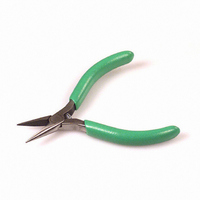L4V Apex Tool Group, L4V Datasheet - Page 41

L4V
Manufacturer Part Number
L4V
Description
PLIER SUBMINIATURE LONG NOSE
Manufacturer
Apex Tool Group
Series
Xcelite®r
Datasheet
1.170M.pdf
(104 pages)
Specifications of L4V
Tip - Type
Needle Nose, Straight
Tool Type
Pliers
Features
Serrated
Length
4.0" (101.6mm)
Weight
0.1 lb (45.36g)
Other names
L-4
L4
L4
L4H
L4
L4
L4H
General
When selecting electronic cutting pliers, you should attempt
to minimize your cost per cut by selecting the proper tool for
each application. The type of cut, cutting area access, cutting
edge quality and user preference will influence your choice.
Type of Cut
Electronic pliers are available with cutting edge angles that
produce standard, semi-flush and flush cuts. These terms
refer to the amount of “pinch” left on the tip of a wire after it
has been cut
Standard cutting edges should be used for applications that
are not sensitive to either the amount of shock transmitted
through the wire to the component (during cutting) or to the
amount of “pinch” left on the wire tip (after cutting).
Semi-flush edges can be employed for most applications.
They reduce shock transmittal and wire tip “pinch.”
Flush edges should be selected only for delicate applica-
tions, which require minimal shock transmittal and wire tip
“pinch.” Flush cutters produce a clean cut, which facilitates
soldering and increases connection reliability. With small cut-
ting edge angles, the life of flush cutters is substantially less
than that of semi-flush cutters. The larger the cutting edge
angle, the more cuts you can expect from the tool. For elec-
tronic assembly work, the semi-flush cutter is often the most
cost-effective choice.
Cutting Area Access
Access to cutting areas can determine the shape and thick-
ness of the cutting head. Tight clearances around the cutting
area, the need to reach over in-place components or to work
from directly above, and visibility requirements are all factors
which will affect your choice of a tool. However, it is important
to recognize that head shape and thickness are directly relat-
ed to cutting edge life
Head Shape
Always select a cutter with the largest head that will meet
your particular cutting requirements. It is a proven fact that
more material behind the cutting edges gives more cuts and
longer life.
Electronic Assembly Tools Plier Selection Information
www.cooperhandtools.com/xcelite
Oval head cutters are the most versatile. They have the most
material behind the cutting edges, and last longest. Tapered
and angled head cutters should be selected only when
access to the cutting area is limited. These cutters have less
head mass, and provide proportionally fewer cuts.
Head Thickness
Head thickness is related to cutting life in the same way as
head shape. Cutting pliers with thicker heads also last longer.
Whenever possible, use pliers with standard head thickness.
Relieved head designs should be chosen only to accommo-
date difficult access problems.
Cutting Edge Quality
The quality of a pair of cutting pliers can be determined by
visual inspection. The blades should meet smoothly and
evenly at the tips. From a point just behind the tips to the
joint, an increasing amount of light should be visible
A precision tip interface assures clean cutting of fine wires,
while the “no contact” area behind the tips extends cutter life
by allowing the tips to continue to meet as they wear.
User Preference
Other considerations can be a matter of personal preference.
Handle shape, grip color, grip material, spring tension and
leverage ratio are usually related to user comfort.
Proper spring tension will allow pliers to open and close with
minimum effort. Finally, pliers with high leverage ratios pro-
vide the greatest ease of use and the longest life.
Leverage Ratio
Leverage ratio is obtained by dividing dimension A into
dimension B.
PLIERS
319










